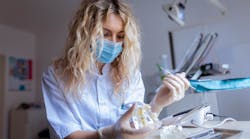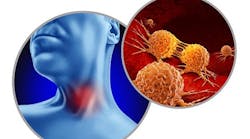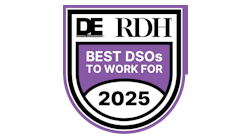Abstract
It is important that students build confidence in their clinical and interpersonal skills while enrolled in a dental hygiene program. Studies have been conducted on different learning techniques to build confidence in students. This literature review takes a closer look at four studies as well as related adult learning theories. These studies include the following techniques: practicum experiences, motivational interviewing (MI), Standardized Patient (SP) training, and blended learning. While practicum experiences and MI were successful in building confidence in dental hygiene students, SP training and blended learning were not.
Confidence in dental hygiene students
One of the most important things a student can gain while enrolled in a dental hygiene program is confidence. Confidence in dental hygiene skills is built with time and experience. Researchers have conducted studies on different ways to increase confidence in dental hygiene students. These studies have included implementing these confidence-building techniques into dental hygiene programs: practicum experiences, motivational interviewing (MI), Standardized Patient (SP) training, and blended learning.
Confidence-building techniques
Practicum experiences
Practicum experiences allow students to connect theory to practice by applying what has been learned in dental hygiene school to real-life clinical situations.1 These hands-on experiences allow dental hygiene students to practice on patients outside of the schools’ clinics, allowing them to discover what works for them personally as hygienists.1 Practicum experiences can also highlight individual shortcomings, allowing students to make improvements prior to graduation.1 Theorist David Kolb believes that adult students learn through experiences and personal involvement.2 Experiential learning allows students to document continuous professional development by capturing, recording, and implementing what is learned into one’s daily practice.2
The great disruption: Dental hygiene education during the pandemic
The missing piece for clinical education: Collaboration
The purpose of this study was to determine if senior dental hygiene students had an increase in clinical self-confidence following practicum experiences in various community clinic locations.1 Thirty-two senior students, enrolled in the University of North Carolina’s dental hygiene program, were evaluated for an increase in confidence. The results from this study indicated that practicum experiences had a positive effect on the self-confidence of students and should be included in dental hygiene programs.1
Motivational interviewing
MI is utilized as a patient-centered counseling approach that is based on collaboration, not compliance, to encourage behavior modification.3 The authors of this study wanted to determine if dental hygiene students utilizing MI had an increase in confidence while delivering oral hygiene instructions to their patients.3
The study involved 22 students who were enrolled in the University of Michigan’s dental hygiene program. The students in this study were able to identify successes and challenges in delivering oral hygiene instructions to patients utilizing MI.3 The results of this study indicated that the students’ perceptions of the importance of MI, as well as their confidence in using the technique, increased over time.3
David Kolb believes that experiential learning involves this four-stage cycle: experience, reflection, conceptualization, and action.2 The participants in this study found that their experience and confidence using MI increased over time. Through reflection, students who utilized MI were able to experience the positive effects of patient modification on oral hygiene. Successful delivery of oral hygiene instructions will encourage students to continue to use MI throughout their dental hygiene careers.
Standardized Patient training
SP training allows students to practice interacting with patients, who are played by actors, in certain situations so that communication skills can be improved.4 This study was conducted to evaluate whether SP training could increase and maintain confidence in dental hygiene students while they delivered counseling on tobacco dependence.4 The six-month study included 27 students who were divided into control and test groups. Students in the test group received SP training for one week, while the control group received no additional training.
Results following the first week of SP training showed that the test group had a significant increase in confidence.4 Results at the end of six months showed that while the test group had a slight decrease in the amount of confidence during tobacco dependence counseling, both the control and test groups showed a comparable amount of increased confidence overall.4 Even though students in the test group were given the opportunity to role-play while delivering tobacco dependence counseling, experiential learning was not achieved, and training for one week was not sufficient to maintain confidence.
Blended learning
Blended learning incorporates online and face-to-face delivery of instruction to students.5 The authors of this study wanted to assess the confidence levels of dental hygiene students in interpreting dental radiographs following a blended learning dental radiography course.5
Sixteen senior students, five months away from graduating, participated in this study. The students were interviewed to determine their levels of confidence in interpreting dental radiographs following the blended learning radiography course. The students stressed the importance of having detailed patient histories, clinical assessment findings, and collaborations with other dental professionals to correctly interpret dental radiographs.5 The results of the study found that students were not confident in their abilities to interpret dental radiographs following the blended learning course.5
Blended learning was not the proper learning environment for a dental radiography course. Malcolm Knowles believed that adult educators must create an environment that encourages students to learn.6 To build confidence in interpreting dental radiographs, the students who participated in this study required an in-person environment with access to patient documents and peer collaboration.
Conclusion
Practicum experiences, MI, SP training, and blended learning courses have been studied to see if they increase confidence in dental hygiene students. Of these techniques, practicum experiences and MI were successful in building students’ confidence. Although there was an increase in the students’ confidence directly after receiving SP training, the increased confidence was not maintained. Students who gained experience in tobacco dependence counseling in the dental hygiene clinic showed the same amount of confidence overall.
Confidence in dental hygiene skills is built through time and experience. Educators in dental hygiene programs can help students build confidence by providing a proper learning environment, practical hands-on experience, and course material that is applicable to real-life clinical situations.
Editor's note: This article appeared in the January/February 2023 print edition of RDH magazine. Dental hygienists in North America are eligible for a complimentary print subscription. Sign up here.
References
- Simonian WZ, Brame JL, Hunt LC, Wilder RS. Practicum experiences: effects on clinical self-confidence of senior dental hygiene students. J Dent Hyg. 2015;89(3):152-161.
- Greenway R. Experiential learning articles and critiques of David Kolb’s theory. https://reviewing.co.uk/research/experiential.learning.htm
- Mills A, Kerschbaum WE, Richards PS, Czarneki GA, Kinney JS, Gwozdek AE. Dental hygiene students’ perceptions of importance and confidence in applying motivational interviewing during patient care. J Dent Hyg. 2017;91(1):15-23.
- Brame JL, Martin R, Tavoc T, Stein M, Curran AE. A randomized controlled trial of the effect of standardized patient scenarios on dental hygiene students’ confidence in providing tobacco dependence counseling. J Dent Hyg. 2012;86(4):282-291.
- Pacheco-Pereira C, Senior A, Green J, Watson E, Rasmussen K, Compton SM. Assessing students’ confidence in interpreting dental radiographs following a blended learning module. Int J Dent Hyg. 2019;17(3):280-287. doi:10.1111/idh.12394
- Lee C. The adult learner: neglected no more. Training. 1998;35(3):47-48.






